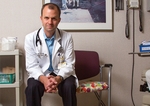Profession
Rethinking physicians' training in chronic disease management
■ Ten medical schools are developing curricula and will offer classes in the fall.
By Bonnie Booth — Posted Feb. 26, 2007
- WITH THIS STORY:
- » Trying something new
- » Related content
Most experts agree that medical education needs a major revision so that future physicians are best able to treat the millions of patients expected to be living with chronic diseases in the foreseeable future.
The system under which medical students are educated and trained continues to be geared toward providing acute care in a hospital setting -- an outdated model when more and more care involves managing chronic conditions in an outpatient setting.
"At present, medical education is based on an acute care model in which patients are examined, diagnosed, treated and released," said David C. Thomas, MD, associate professor of medicine and medical director of the division of general internal medicine at Mt. Sinai School of Medicine in New York. "Chronic illness is much more longitudinal. That's not a culture that physicians have grown up in. Now doctors need to gather much more information from their patients and then partner with them."
Mt. Sinai is one of 10 medical schools to which the Assn. of American Medical Colleges awarded grant money to figure out the best way to shift the focus of medical education to chronic disease management in doctors' offices and clinics.
At the start of the 2006-07 academic year, each school received grants totaling $100,000 over two years, the AAMC said. The first year is reserved for planning. In the second year, the schools will implement curriculum changes. Funding for changes in residency programs has been issued to nine institutions, which each received a $75,000 one-year planning grant. One of the 10 schools does not have a residency program.
The AAMC's Institute for Improving Medical Education awarded the grants to help medical schools redesign curricula and residency training programs to focus more on treating chronic conditions. The AAMC estimates that more than 100 million patients are affected by chronic illness and that the number will only increase as the population ages.
Participating schools are required to distribute chronic care illness education throughout the four-year curriculum, the AAMC said. Students must observe team approaches to chronic care, establish long-term relationships with patients and understand challenges patients face daily as they navigate the health care system.
That is a key change being implemented at Mt. Sinai, Dr. Thomas said. "It is going to be a unique, long-term relationship between students and chronically ill patients and their health care providers," he added.
Dr. Thomas is part of a team of physician educators, social workers, nurse practitioners and family physicians working to envision a new training program to prepare residents for office-based treatment of chronic conditions. The Mt. Sinai team will prepare a report for the AAMC.
Experts agree that changing education is just one component in preparing doctors for a new reality, and that it is a good first step.
"It's going to take initiatives at every level, including financing," said Diane Meier, director of the Center to Advance Palliative Care at Mt. Sinai.
"Curricula is the first step, but every part of the system is important because they are interwoven."












